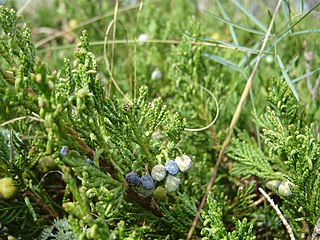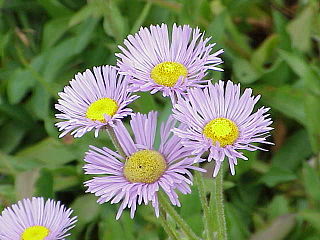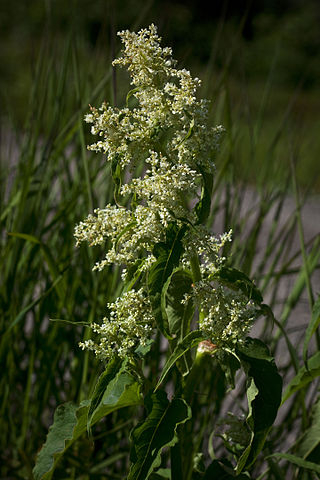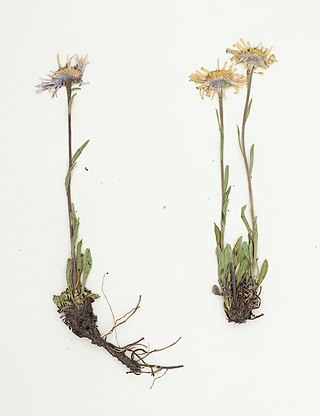
Arnica is a genus of perennial, herbaceous plants in the sunflower family (Asteraceae). The genus name Arnica may be derived from the Greek arni, "lamb", in reference to the plants' soft, hairy leaves. Arnica is also known by the names mountain tobacco and confusingly, leopard's bane and wolfsbane—two names that it shares with the entirely unrelated genus Aconitum.

Ovis dalli, also known as the Dall sheep or thinhorn sheep, is a species of wild sheep native to northwestern North America. Ovis dalli contains two subspecies: Ovis dalli dalli and Ovis dalli stonei. O. dalli live in mountainous alpine habitats distributed across northwestern British Columbia, the Yukon, Northwest Territories and Alaska. They browse a variety of plants such as grasses, sedges and even shrubs such as willow, during different times of the year. They also acquire minerals to supplement their diet from mineral licks. Like other Ovis species, the rams engage in dominance contests with their horns.

The singing vole, is a medium-sized vole found in northwestern North America, including Alaska and northwestern Canada.

Juniperus horizontalis, the creeping juniper or creeping cedar, is a low-growing shrubby juniper native to northern North America, throughout most of Canada from Yukon east to Newfoundland, and in some of the northern United States.

Glyceria is a widespread genus of grass family common across Eurasia, Australia, North Africa, and the Americas.
Erigeron muirii, or Muir's fleabane, is a rare Arctic species of flowering plant in the family Asteraceae. It has been found only in northern Alaska and the northern Yukon Territory, including Herschel Island in the Arctic Ocean. It grows in tundra, dry slopes, and rock outcrops.

The Koyukuk National Wildlife Refuge is a 3,500,000-acre (14,000 km2) conservation area in Alaska. It lies within the floodplain of the Koyukuk River, in a basin that extends from the Yukon River to the Purcell Mountains and the foothills of the Brooks Range. This region of wetlands is home to fish, waterfowl, beaver and Alaskan moose, and wooded lowlands where two species of fox, bears, wolf packs, Canadian lynx and marten prowl.
Podistera nevadensis is an uncommon species of flowering plant in the carrot family known by the common names Sierra podistera and Nevada podistera.

Mertensia paniculata, also known as the tall lungwort, tall bluebells, or northern bluebells, is an herb or dwarf shrub with drooping bright-blue, bell-shaped flowers. It is native to northwestern North America and the Great Lakes.

Arctostaphylos rubra is a species of flowering plant in the heath family and the genus Arctostaphylos, the manzanitas and bearberries. Common names include red fruit bearberry, alpine bearberry, arctic bearberry, red manzanita, and ravenberry. It is native to Eurasia and northern North America from Alaska through most of Canada to Greenland. There is also one population in the contiguous United States, located in the Absaroka Mountains of Wyoming.

Salix brachycarpa is a species of flowering plant in the willow family known by the common names barren-ground willow, small-fruit willow and shortfruit willow.

Salix hastata is a species of flowering plant in the willow family, known by the common name halberd willow. It has an almost circumpolar distribution, occurring throughout the northern latitudes of the Northern Hemisphere, most frequently found near the coast of the Arctic Ocean. In Alaska, it occurs in the north and in the central mountains. It also occurs in northwestern Canada, and in Norway and Russia, as well as various alpine or mountainous areas of Eurasia.
Salix monticola is a species of flowering plant in the willow family known by the common names mountain willow, cherry willow, serviceberry willow, and park willow. It is native to the United States, where it occurs in the Rocky Mountains region from Wyoming to Arizona and New Mexico. It also occurs in Alaska and parts of Canada.

Salix pulchra is a species of flowering plant in the willow family, known by the common names diamondleaf willow, tealeaf willow, and thin red willow. It is native to northern North America, where it occurs in Alaska, Yukon, the Northwest Territories, and Nunavut. The species is also found in northern British Columbia, and occurs in Russia.
Rorippa barbareifolia, the hoary yellowcress, is a plant species reported from Manchuria, Inner Mongolia, Mongolia, Siberia, Alaska, Yukon and Saskatchewan. It grows in wet habitats. It can be found along forest borders, in ditches, on stream banks, etc.

Castilleja caudata, common name Port Clarence Indian paintbrush or pale Indian paintbrush, is a plant species native to Alaska, Yukon, Northwest Territories, Nunavut, and the northeastern part of Asiatic Russia. The first common name refers to Port Clarence, on the north coast of the Bering Sea just south of Nome.
Minuartia yukonensis, the Yukon sandwort or Yukon stitchwort, is a plant species native to Yukon and Northwest Territories of Canada, as well as Alaska, and The Russian Far East. Flora of North America and some other publications also report it from British Columbia, but more recent work shows those collections to have been misidentified. Minuartia yukonensis grows in dry, rocky meadows at elevations less than 1000 m.

Erigeron glabellus is a North American species of flowering plants in the family Asteraceae, called the streamside fleabane.

Koenigia alaskana is an Asian and North American species of flowering plant in the buckwheat family known by the common names Alaska wild-rhubarb and alpine knotweed.

Symphyotrichum yukonense is a species of flowering plant in the family Asteraceae endemic to disjunct areas in Alaska and the Canadian territories of Yukon and Northwest Territories. Commonly known as Yukon aster, it is a perennial, herbaceous plant 5 to 30 centimeters in height. Its flowers have purple to blue ray florets and yellow to brown disk florets. S. yukonense grows at elevations of 300–1,500 meters in mud flats and on sandy or silty lake shores. It is a NatureServe Vulnerable (G3) species and is classified Imperiled (S2) in its Canadian range.














